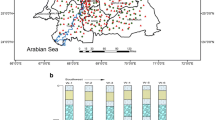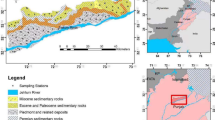Abstract
This paper reports high levels and variability in arsenic (As) levels at locations identified as one of the highest As-contaminated locations in Pakistan. Groundwater pollution related to arsenic has been reported since many years in the areas lying in outskirts of District Lahore, Pakistan. A comparative study is done to determine temporal variations of As from three villages, i.e., Kalalanwala (KLW), Manga Mandi (MM), and Shamki Bhattian (SKB). Seventy-three percent of the 30 investigated samples ranging in depth from 20 to 200 m, show an increasing trend in variations of As concentration over a time span of 4 years and 87 % of samples exceeded the WHO standard of 10 μg/L for As while 77 % of samples have As concentration >50 μg/L (national standard). Further results indicate that high levels of As is accompanied with increase pH (r = 0.8) favoring desorption of As from minerals at higher pH under oxidizing conditions. For health risk assessment of arsenic, the average daily dose, hazard quotient (HQ), and cancer risk were calculated. The residents of the studied areas had toxic risk index in the order of SKB>KLW>MM, with 87 % of samples exceeding the typical toxic risk index 1.00 (ranging from 2.3–48.6) which was 83 % (ranging from 0.3–41) 4 years before. The results of the present study therefore indicate that arsenic concentrations are increasing in the area, which needs an immediate attention to provide alternate sources of water to save people at risk.





Similar content being viewed by others
References
Ahmed, M. F., Ahuja, S., Alauddin, M., Hug, S. J., Lloyd, J. R., Pfaff, A., et al. (2006). Ensuring safe drinking water in Bangladesh. Science, 314, 1686–1688.
Alauddin, M., Rahman, M. N., Munir, A. K. M., Mahiyuddin, G., & Hossin, B. B. (2000). Temporal variation of inorganic arsenic in groundwater of two contaminated tubewells. Journal of Applied Science and Technology, 01(01), 33–38.
Amini, M., Abbaspour, K. C., Berg, M., Winkel, L., Hug, S. J., Hoehn, E., et al. (2008). Statistical modeling of global geogenic arsenic contamination in groundwater. Environmental Science and Technology, 42, 3669–3675.
Arain, M. B., Kazi, T. G., Jamali, M. K., Jalbani, N., Afridi, H. I., & Shah, A. (2008). Total dissolved and bioavailable elements in water and sediment samples and their accumulation in Oreochromis mossambicus of polluted Manchar Lake. Chemosphere, 70(10), 1845–1856.
Arain, M. B., Kazi, T. G., Baig, J. A., Jamali, M. K., Afridi, H. I., & Shah, A. Q. (2009). Determination of arsenic levels in lake water, sediment, and foodstuff from selected area of Sindh, Pakistan: estimation of daily dietary intake. Food and Chemical Toxicology, 47, 242–248.
Baig, J. A., Kazi, T. G., Arain, M. B., Afridi, H. M., Kandhro, G. A., Sarfraz, R. A., et al. (2009). Evaluation of arsenic and other physico-chemical parameters of surface and ground water of Jamshoro, Pakistan. Journal of Hazardous Material, 166, 662–669.
Brahman, K. D., Kazi, T. G., Afridi, H. I., Naseem, S., Arain, S. S., & Ullah, N. (2013). Evaluation of high levels of fluoride, arsenic species and other physicochemical parameters in underground water of two sub districts of Tharparkar, Pakistan: a multivariate study. Water Research, 47, 1005–1020.
Bundschuh, J., Farias, B., Martin, R., Storniolo, A., Bhattachary, P., Cortes, J., et al. (2004). Groundwater arsenic in the Chaco-Pampean Plain, Argentina: case study from Robles county, Santiago del Estero Province. Applied Geochemistry, 19, 231–243.
Carelli, V., Ross-Cisneros, F. N., & Sadun, A. A. (2002). Optic nerve degeneration and mitochondrial dysfunction: genetic and acquired optic neuropathies. Neurochemistry International, 40(6), 573–584.
Caylak, E. (2012). Health risk assessment for arsenic in water sources of Cankiri Province of Turkey. CLEAN - Soil, Air, Water, 40(7), 728–734.
Chen, Y., Graziano, J. H., Parvez, F., Liu, M., Slavkovich, V., Kalra, T., et al. (2011). Arsenic exposure from drinking water and mortality from cardiovascular disease in Bangladesh: Prospective cohort study. British Medical Journal, 342, d2431.
Cheng, Z., Geen, A. V., Seddique, A. A., & Ahmed, K. M. (2005). Limited Temporal variability of arsenic concentrations in 20 wells monitored for 3 years in Araihazar, Bangladesh. Environmental Science and Technology, 39, 4759–4766.
Chowdary, V. M., Rao, N. H., & Sarma, P. B. S. (2005). Decision support framework for assessment of non-point-source pollution of groundwater in large irrigation projects. Agricultural Water Management, 75, 194–225.
Concha, G., Nermell, B., & Vahter, M. (2006). Spatial and temporal variations in arsenic exposure via drinking-water in Northern Argentina. Journal of Health, Population and Nutrition, 24(3), 317–326.
Dzombak, D. A., & Morel, F. M. M. (1990). Surface complexation modeling—hydrous ferric oxide. New York: Wiley.
Erickson, M. L., & Barnes, R. J. (2006). Arsenic concentration variability in public water system wells in Minnesota, USA. Applied Geochemistry, 21, 305–317.
Farooqi, A., Masuda, H., & Firdous, N. (2007a). Toxic fluoride and arsenic contaminated groundwater in the Lahore and Kasur districts, Punjab, Pakistan and possible contaminant sources. Environmental Pollution, 145, 839–849.
Farooqi, A., Masuda, H., Kusakabe, M., Naseem, M., & Firdous, N. (2007b). Distribution of highly arsenic and fluoride contaminated groundwater from east Punjab, Pakistan, and the controlling role of anthropogenic pollutants in the natural hydrological cycle. Geochemical Journal, 41(4), 213–234.
Farooqi, A., Masuda, H., Siddique, R., & Naseem, M. (2009). Sources of arsenic and fluoride in highly contaminated soils causing groundwater contamination in Punjab, Pakistan. Archives of Environmental Contamination and Toxicology, 56, 693–706.
Fuller, C. C., & Davis, J. A. (1989). Influence of coupling of sorption and photosynthetic processes on trace element cycles in natural waters. Nature, 340, 52–54.
Graziano C., Toxicity, arsenic. (Accessed December 2012). Available from: http://www.emedicine.com
Gupta, A., Chauhan, V. S., & Sankararamakrishnan, N. (2009). Preparation and evaluation of iron–chitosan composites for removal of As(III) and As(V) from arsenic contaminated real life groundwater. Water Research, 43(15), 3862–3870.
Halim, M. A., Majumder, R. K., Nessa, S. A., Hiroshiro, Y., Uddin, M. J., Shimada, J., et al. (2009). Hydrogeochemistry and arsenic contamination of groundwater in the Ganges Delta Plain, Bangladesh. Journal of Hazardous Materials, 164, 1335–1345.
Harvey, C. F., Swartz, C. H., Badruzzaman, A. B. M., Keon-Blute, N., Yu, W., Ali, M. A., et al. (2002). Arsenic mobility and groundwater extraction in Bangladesh. Science 22, 298(5598), 1602–1606.
Hinkle, S. R., & Polette, D. J. (1999). Arsenic in ground water of the Willamette Basin, Oregon (pp. 98–4205). Washington, D.C: U. S. Geological Survey Water Resources Investigations.
Kaltreider, R. C., Davis, A. M., Lariviere, J. P., & Hamilton, J. W. (2006). Arsenic alters the function of the glucocorticoid receptor as a transcription factor. Environmental Health Perspective, 109(3), 245–251.
Karim, M. M. D. (2000). Arsenic in groundwater and health problems in Bangladesh. Water Research, 34, 304–310.
Kavcar, P., Sofuoglu, A., & Sofuoglu, S. C. (2009). A health risk assessment for exposure to trace metals via drinking water ingestion pathway. International Journal of Hygiene and Environmental Health, 212, 216–227.
Khan, S., Shahnaz, M., Jehan, N., Rehman, S., Shah, M. T., & Din, I. (2012). Drinking water quality and human health risk in Charsadda district. Pakistan Journal of Cleaner Production, xxx, 1–9.
Liu, A. G., Ming, J. H., & Ankumah, R. O. (2005). Nitrate contamination in private wells in rural Alabama, United States. Science of Total Environment, 346, 112–120.
Mohan, D., & Pittman, C. U. (2007). Arsenic removal from water/wastewater using adsorbents—a critical review. Journal of Hazardous Materials, 142, 1–53.
Mostofa, K. M. G., Liu, C. Q., Pan, X. L., Yoshioka, T., Vione, D., Minakata, D., et al. (2013). Photosynthesis in nature: a new look. In K. M. G. Mostofa, T. Yoshioka, A. Mottaleb, & D. Vione (Eds.), Photobiogeochemistry of organic matter: principles and practices in water environments (Springer, New York, Chapter, Vol. 7, pp. 561–686).
Muhammad, S., Shah, M. T., & Khan, S. (2010). Arsenic health risk assessment in drinking water and source apportionment using multivariate statistical techniques in Kohistan region, northern Pakistan. Food and Chemical Toxicology, 48, 2855–2864.
Nguyen, V. A., Bang, S., Viet, P. H., & Kim, K. W. (2009). Contamination of groundwater and risk assessment for arsenic exposure in Ha Nam province, Vietnam. Environment International, 35, 466–472.
Nickson, R. T., McArthur, J. M., Shrestha, B., Kyaw-Myint, T. O., & Lowry, D. (2005). Arsenic and other drinking water quality issues, Muzaffargarh District, Pakistan. Applied Geochemistry, 20, 55–68.
Ning, R. Y. (2002). Asenic removal by reverse osmosis. Desalinisation, 143, 237–241.
Parvez, F., Wasserman, G. A., Factor-Litvak, P., Liu, X., Slavkovich, V., Siddique, A. B., et al. (2011). Arsenic exposure and motor function among children in Bangladesh. Environmental Health Perspective, 119, 1665–1670.
Rahman, A., Persson, L., Nermell, B., Arifeen, S. E., Ekstorm, E., Smith, A., et al. (2010). Arsenic exposure and risk of spontaneous abortion, stillbirth, and infant mortality. Epidemiology, 21, 797–804.
Reghunath, R., Murthy, T. R. J., & Raghavan, B. R. (2002). The utility of multivariate statistical techniques in hydrogeochemical studies: an example from Karnataka. India. Water Research, 36, 2437–2442.
Sadun, A. A. (2002). Metabolic optic neuropathies. Seminars in Ophthalmology, 17(1), 29–32.
Shah, M.T. (2000). Mineralogy, chemistry and genesis of the proterozoic base metals deposits at the northern margin of Indian plate, in the Besham area Himalaya, northern Pakistan. In: Hussian, S.S., Akbar, H.M. (Eds.), Economic Geology of Pakistan, 11–57.
Smedley, P. L., & Kinniburgh, D. G. (2002). A review of the source, behaviour and distribution of arsenic in natural waters. Applied Geochemistry, 17, 517–568.
Smith, A. H., Lingas, E. O., & Rahman, M. (2000). Contamination of drinking-water by arsenic in Bangladesh: a public health emergency. Bulletin of the World Health Organization, 78(9), 1093–1103.
Steinmaus, C. M., Yuan, Y., & Smith, A. H. (2005). The temporal stability of arsenic concentrations in well water in western Nevada. Environmental Research, 99, 164–168.
Stumm, Werner, and Morgan, J.J. (1996). Aquatic chemistry New York, Wiley, 3rd Edition, 1022
UN WWAP (2009). United Nations World Water Assessment Programme. The World Water Development Report 3: Water in a Changing World. UNESCO, Paris, France. Retrieved 18 May, 2011 from http://www.unwater.org/wwd10/downloads/WWD2010_Facts_web.pdf
US Environmental Protection Agency (USEPA), (1998). Arsenic, inorganic. United States Environmental Protection Agency, Integrated Risk Information System (IRIS), (CASRN 7440-38-2). http://www.epa.gov/iris/subst/0278.htm
US Environmental Protection Agency (USEPA), (2005). Guidelines for carcinogen Risk assessment. Risk Assessment Forum, Washington, DC, EPA/630/P-03/001F
Wasserman, G. A., Liu, X., Parvez, F., Ahsan, H., Factor-Litvak, P., Van Geen, A., et al. (2004). Water arsenic exposure and children’s intellectual function in Araihazar, Bangladesh. Environmental Health Perspective, 112, 1329–1333.
Waychunas, G. A., Rea, B. A., Fuller, C. C., & Davis, J. A. (1993). Surface chemistry of ferrihydrite–Part 1–EXAFS studies of the geometry of coprecipitated and adsorbed arsenate. Geochimica et Cosmochimica Acta, 57, 2251–2269.
WHO (World Health Organisation), (1999). Arsenic in drinking water. Fact sheet no. 210, Geneva, WHO
Xie, X., Ellis, A., Wang, Y., Xie, Z., Duan, M., & Su, C. (2009). Geochemistry of redox-sensitive elements and sulfur isotopes in the high arsenic groundwater system of Datong Basin, China. Science of The Total Environment, 407(12), 3823–3835.
Zhang, X., Wang, Q., Liu, Y., Wu, J., & Yu, M. (2011). Application of multivariate statistical techniques in the assessment of water quality in the Southwest New Territories and Kowloon, Hong Kong. Environmental Monitoring and Assessment, 173, 17–27.
Acknowledgments
The authors are thankful to Ms. Mehwish Ramzan for technical assistance.
Author information
Authors and Affiliations
Corresponding author
Rights and permissions
About this article
Cite this article
Sultana, J., Farooqi, A. & Ali, U. Arsenic concentration variability, health risk assessment, and source identification using multivariate analysis in selected villages of public water system, Lahore, Pakistan. Environ Monit Assess 186, 1241–1251 (2014). https://doi.org/10.1007/s10661-013-3453-3
Received:
Accepted:
Published:
Issue Date:
DOI: https://doi.org/10.1007/s10661-013-3453-3




